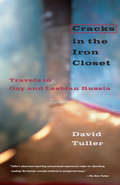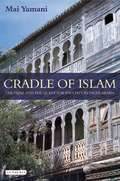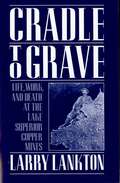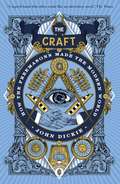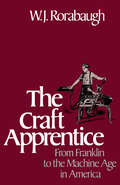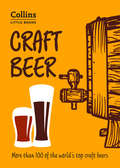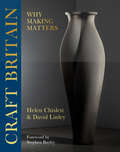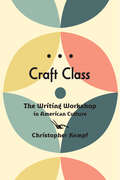- Table View
- List View
Cracking Economics (Cracking Series)
by Tejvan PettingerCrack the world of money and understand the economic theory that has shaped nations and influenced the way you live now.From Keynesian models to how inflation affects interest rates, Cracking Economics will make the seemingly complex world of global finance easily understood. Subjects covered include:-Macro- and micro-economics-Inflation-Recession-Economic forecasting-How stock markets work-Globalisation-Labour markets-The credit crunch-Keynesian theory-Conceptual economics-The EuroAn accessible, comprehensive and fully illustrated guide to this fascinating field, Cracking Economics will get you conversing on currency and discussing the deficit with the best of them.
Cracking the Einstein Code: Relativity and the Birth of Black Hole Physics
by Fulvio MeliaAlbert Einstein’s theory of general relativity describes the effect of gravitation on the shape of space and the flow of time. But for more than four decades after its publication, the theory remained largely a curiosity for scientists; however accurate it seemed, Einstein’s mathematical code—represented by six interlocking equations—was one of the most difficult to crack in all of science. That is, until a twenty-nine-year-old Cambridge graduate solved the great riddle in 1963. Roy Kerr’s solution emerged coincidentally with the discovery of black holes that same year and provided fertile testing ground—at long last—for general relativity. Today, scientists routinely cite the Kerr solution, but even among specialists, few know the story of how Kerr cracked Einstein’s code. Fulvio Melia here offers an eyewitness account of the events leading up to Kerr’s great discovery. Cracking the Einstein Code vividly describes how luminaries such as Karl Schwarzschild, David Hilbert, and Emmy Noether set the stage for the Kerr solution; how Kerr came to make his breakthrough; and how scientists such as Roger Penrose, Kip Thorne, and Stephen Hawking used the accomplishment to refine and expand modern astronomy and physics. Today more than 300 million supermassive black holes are suspected of anchoring their host galaxies across the cosmos, and the Kerr solution is what astronomers and astrophysicists use to describe much of their behavior. By unmasking the history behind the search for a real world solution to Einstein’s field equations, Melia offers a first-hand account of an important but untold story. Sometimes dramatic, often exhilarating, but always attuned to the human element, Cracking the Einstein Code is ultimately a showcase of how important science gets done.
Cracking the Einstein Code: Relativity and the Birth of Black Hole Physics
by Fulvio MeliaAlbert Einstein’s theory of general relativity describes the effect of gravitation on the shape of space and the flow of time. But for more than four decades after its publication, the theory remained largely a curiosity for scientists; however accurate it seemed, Einstein’s mathematical code—represented by six interlocking equations—was one of the most difficult to crack in all of science. That is, until a twenty-nine-year-old Cambridge graduate solved the great riddle in 1963. Roy Kerr’s solution emerged coincidentally with the discovery of black holes that same year and provided fertile testing ground—at long last—for general relativity. Today, scientists routinely cite the Kerr solution, but even among specialists, few know the story of how Kerr cracked Einstein’s code. Fulvio Melia here offers an eyewitness account of the events leading up to Kerr’s great discovery. Cracking the Einstein Code vividly describes how luminaries such as Karl Schwarzschild, David Hilbert, and Emmy Noether set the stage for the Kerr solution; how Kerr came to make his breakthrough; and how scientists such as Roger Penrose, Kip Thorne, and Stephen Hawking used the accomplishment to refine and expand modern astronomy and physics. Today more than 300 million supermassive black holes are suspected of anchoring their host galaxies across the cosmos, and the Kerr solution is what astronomers and astrophysicists use to describe much of their behavior. By unmasking the history behind the search for a real world solution to Einstein’s field equations, Melia offers a first-hand account of an important but untold story. Sometimes dramatic, often exhilarating, but always attuned to the human element, Cracking the Einstein Code is ultimately a showcase of how important science gets done.
Cracks in the Dome: Fractured Histories Of Empire In The Zanzibar Museum, 1897-1964
by Sarah LongairAs one of the most monumental and recognisable landmarks from Zanzibar’s years as a British Protectorate, the distinctive domed building of the Zanzibar Museum (also known as the Beit al-Amani or Peace Memorial Museum) is widely known and familiar to Zanzibaris and visitors alike. Yet the complicated and compelling history behind its construction and collection has been overlooked by historians until now. Drawing on a rich and wide range of hitherto unexplored archival, photographic, architectural and material evidence, this book is the first serious investigation of this remarkable institution. Although the museum was not opened until 1925, this book traces the longer history of colonial display which culminated in the establishment of the Zanzibar Museum. It reveals the complexity of colonial knowledge production in the changing political context of the twentieth century British Empire and explores the broad spectrum of people from diverse communities who shaped its existence as staff, informants, collectors and teachers. Through vivid narratives involving people, objects and exhibits, this book exposes the fractures, contradictions and tensions in creating and maintaining a colonial museum, and casts light on the conflicted character of the ’colonial mission’ in eastern Africa.
Cracks in the Dome: Fractured Histories of Empire in the Zanzibar Museum, 1897-1964
by Sarah LongairAs one of the most monumental and recognisable landmarks from Zanzibar’s years as a British Protectorate, the distinctive domed building of the Zanzibar Museum (also known as the Beit al-Amani or Peace Memorial Museum) is widely known and familiar to Zanzibaris and visitors alike. Yet the complicated and compelling history behind its construction and collection has been overlooked by historians until now. Drawing on a rich and wide range of hitherto unexplored archival, photographic, architectural and material evidence, this book is the first serious investigation of this remarkable institution. Although the museum was not opened until 1925, this book traces the longer history of colonial display which culminated in the establishment of the Zanzibar Museum. It reveals the complexity of colonial knowledge production in the changing political context of the twentieth century British Empire and explores the broad spectrum of people from diverse communities who shaped its existence as staff, informants, collectors and teachers. Through vivid narratives involving people, objects and exhibits, this book exposes the fractures, contradictions and tensions in creating and maintaining a colonial museum, and casts light on the conflicted character of the ’colonial mission’ in eastern Africa.
Cracks in the Iron Closet: Travels in Gay and Lesbian Russia
by David TullerDavid Tuller provides the first look into the emotional and sexual lives of Russian lesbians and gays and the pervasive influence of the state on gay life. Part travelogue, part social history, and part journalistic inquiry, the book challenges our assumptions about what it means to be gay. The book also explores key issues in Russia and Soviet life, including concepts of friendship, community, gender, love, fate, and the relationship between the public and private spheres. "Tuller's observant reporting and personal experiences make for absorbing reading: the human comedy rendered in unexpected ways."—New Yorker "Anyone who thinks San Francisco is the world capital of sexual polymorphism should read this book."—Adam Goodheart, Washington Post "[This book is] is profoundly moving."—Jim Van Buskirk, San Francisco Chronicle
Cracks in the Wall: Beyond Apartheid in Palestine/Israel
by Ben WhiteAfter decades of occupation and creeping annexation, the situation on the ground in Palestine/Israel can only be described as a system of apartheid. Peace efforts have failed because of one, inconvenient truth: the Israeli maximum on offer does not meet the Palestinian minimum, or the standards of international law.*BR**BR*But while the situation on the ground is bleak, Ben White argues that there are widening cracks in Israel's traditional pillars of support. Opposition to Israeli policies and even critiques of Zionism are growing in Jewish communities, as well as amongst Western progressives. The election of Donald Trump has served as a catalyst for these processes, including the transformation of Israel from a partisan issue into one that divides the US establishment. Meanwhile, the Palestinian-led boycott campaign is gathering momentum, prompting a desperate backlash by Israel and its allies.*BR**BR*With sharp analysis, Ben White says now is the time to plot a course that avoids the mistakes of the past - a way forward beyond apartheid in Palestine. The solution is not partition and ethnic separation, but equality and self-determination - for all.
Cracks in the Wall: Beyond Apartheid in Palestine/Israel
by Ben WhiteAfter decades of occupation and creeping annexation, the situation on the ground in Palestine/Israel can only be described as a system of apartheid. Peace efforts have failed because of one, inconvenient truth: the Israeli maximum on offer does not meet the Palestinian minimum, or the standards of international law.*BR**BR*But while the situation on the ground is bleak, Ben White argues that there are widening cracks in Israel's traditional pillars of support. Opposition to Israeli policies and even critiques of Zionism are growing in Jewish communities, as well as amongst Western progressives. The election of Donald Trump has served as a catalyst for these processes, including the transformation of Israel from a partisan issue into one that divides the US establishment. Meanwhile, the Palestinian-led boycott campaign is gathering momentum, prompting a desperate backlash by Israel and its allies.*BR**BR*With sharp analysis, Ben White says now is the time to plot a course that avoids the mistakes of the past - a way forward beyond apartheid in Palestine. The solution is not partition and ethnic separation, but equality and self-determination - for all.
Cradle of Islam: The Hijaz and the Quest for an Arabian Identity
by Mai YamaniIn 1932 the Al Saud family incorporated the Kingdom of the Hijaz into the new Kingdom of Saudi Arabia. The Hijazis became a people without a country of their own, who nonetheless have since retained a separate cultural consciousness. Cradle of Islam focuses on contemporary Hijazi life and culture, made subservient to the dominant national rules of Saudi Arabia, as dictated by a political and religious elite rooted in the central Najd region of the country. The urban, cosmopolitan culture of Mecca and Medina in the heartland of the Hijaz flourished under the Hashemite 'Ashraf', particularly during Ottoman rule in the Arabian peninsula. By contrast, Saudi power has consistently pursued a national project aimed at subverting any non-Najdi regional distinctiveness. But the enormous resources of the Saudi state have been insufficient to assimilate or tame Saudi Arabia's regional cultures. The Al Saud family could dominatebut they could not integrate. Cradle of Islam is the product of in-depth research in Mecca, Medina, Jeddah, Taif and other parts of the Hijaz. It documents the Hijazi urban elites' resistance to the Saudi national project. Set in their historical context, accounts of Hijazis' everyday life reveal their response against 'Najdification'. The Hijazis express their identity by establishing clear cultural boundaries to distinguish themselves as specifically Hijazis. The self-conscious distinctiveness and perceived superior ways of the Hijazi awai'l - the elite group of Hijazi families - constantly emphasise their identity and culture as a kind of subtle unspoken challenge to Najdi domination. Every detail of Hijazi life - rites of passage ceremonies, food, language, dress and religious rituals - become an announcement of identity. In the process this can often create an exaggerated sense of selfimportance that is laced with its own pretensions.Cradle of Islam is based on an insider's account of the hidden world of the Hijazi. In a climate of increasing interest in Saudi Arabia, this extraordinarily original book makes a crucial contribution to a better understanding of the dilemmas facing the Saudi state. 'My father was born in Mecca and much of what I have read here reminds me ofmy father, grandfather and relations. Mai Yamani has provided us with a uniqueperspective on the Hijaz. This is an invaluable contribution to the social andpolitical history of a hitherto largely unknown, ignored and unrecognised people.An irrefutably powerful argument for the preservation of cultural identity, respectfor human dignity and a celebration of our human diversity.'- HRH Prince Hassan of Jordan'Mai Yamani is consistently the sharpest observer of modern Saudi Arabia and paints a vivid picture of the cauldron of political and religious divisions that are tearing it apart. This is a major contribution to the study of Arab diversity – at a time when the West urgently needs to understand it.' - Tim Sebastian, BBC Hard Talk'A vivid and vibrant picture of Hijazi society and its transformations in the twentieth century, from intimate domestic culture to public performance and political ritual. A particular insight into female society and its active culture.' - Sami Zubaida, Professor of Sociology at Birkbeck College, University of London'Dr. Mai Yamani's book is a real delight. She penetrates the external Saudi covering layer, to reveal the Hijazi socio-cultural existence, and its customs and social structure in vibrant colours. Her analysis is descriptive interpretation at its best.' - Joseph Kostiner, co-editor of Tribes: State Formation in the Middle East'Mai Yamani's book is a very rare thing. A detailed, informative and rigorous investigation into the most important but understudied country in the Middle East: Saudi Arabia. Yamani's book should be required reading for anyone trying to understand the evolution of Saudi Arabia, its place in Middle Eastern politics and why it has come to play such an important role in the international politics of the post-Cold War era.' - Toby Dodge, Senior Research Fellow, University of Warwick;
Cradle of Islam: The Hijaz and the Quest for an Arabian Identity
by Mai YamaniIs Saudi Arabia really a homogeneous Wahhabi dominated state? In 1932 the Al Saud family incorporated the kingdom of Hijaz, once the cultural hub of the Arabian world, in to the kingdom of Saudi Arabia. The urban, cosmopolitan Hijazis were absorbed in to a new state whose codes of behavior and rules were determined by the Najdis, an ascetic desert people, from whom the Al Saud family came. But the Saudi rulers failed to fully integrate the Hijaz, which retains a distinctive identity to this day. In "Cradle of Islam", the product of years spent in Mecca, Medina, Jeddah and Taif, Mai Yamani traces the fortunes of the distinctive and resilient culture of the Hijazis, from the golden age of Hashemite Mecca to Saudi domination to its current resurgence. The Hijazis today emphasise their regional heritage in religious ritual, food, dress and language as a response to the 'Najdification' of everyday life. The Hijazi experience shows the vitality of cultural diversity in the face of political repression in the Arab world.
Cradle of Thorns: A spell-binding saga of escape, love and family
by Josephine CoxForced to flee from home, a young woman faces the unknown... but not alone. Cradle of Thorns is a spell-binding tale of freedom in the face of fear from bestselling author Josephine Cox. Perfect for fans of Rosie Goodwin and Lindsey Hutchinson.Nell Reece has never known her mother, and her father's burden of guilt about his wife has kept him cowed for years, working as a common labourer on his sister's farm. But for all her aunt's spiteful attempts to break Nell's independent spirit, she has never succeeded. But now Nell, pregnant and alone, is forced to leave behind the men in her life, believing she might never be able to return.With little but the clothes she wears, she travels across the Bedfordshire countryside of 1890. When she encounters a scruffy urchin called Kit, a ten-year-old orphan who's lived his whole life on the streets, she takes him under her wing. The pair become devoted friends, never knowing where their journey will take them, but each aware that the time will come when there must be a reckoning. What readers are saying about Cradle of Thorns: 'What a fantastic read. As soon as I started reading couldn't put the book down, each turn of the page the story gets better and better''Best read in ages. Couldn't put it down - some sad parts, some funny, so real it draws you in''I was captivated by the story from beginning to end'
Cradle to Grave: Life, Work, and Death at the Lake Superior Copper Mines
by Larry LanktonConcentrating on technology, economics, labor, and social history, Cradle to Grave documents the full life cycle of one of America's great mineral ranges from the 1840s to the 1960s. Lankton examines the workers' world underground, but is equally concerned with the mining communities on the surface. For the first fifty years of development, these mining communities remained remarkably harmonious, even while new, large companies obliterated traditional forms of organization and work within the industry. By 1890, however, the Lake Superior copper industry of upper Michigan started facing many challenges, including strong economic competition and a declining profit margin; growing worker dissatisfaction with both living and working conditions; and erosion of the companies' hegemony in a district they once controlled. Lankton traces technological changes within the mines and provides a thorough investigation of mine accidents and safety. He then focuses on social and labor history, dealing especially with the issue of how company paternalism exerted social control over the work force. A social history of technology, Cradle to Grave will appeal to labor, social and business historians.
Craft: An American History (The\journal Of Modern Craft Ser. #No. 1)
by Glenn AdamsonA groundbreaking and endlessly surprising history of how artisans created America, from the nation's origins to the present day. At the center of the United States' economic and social development, according to conventional wisdom, are industry and technology-while craftspeople and handmade objects are relegated to a bygone past. Renowned historian Glenn Adamson turns that narrative on its head in this innovative account, revealing makers' central role in shaping America's identity. Examine any phase of the nation's struggle to define itself, and artisans are there-from the silversmith Paul Revere and the revolutionary carpenters and blacksmiths who hurled tea into Boston Harbor, to today's “maker movement.” From Mother Jones to Rosie the Riveter. From Betsy Ross to Rosa Parks. From suffrage banners to the AIDS Quilt. Adamson shows that craft has long been implicated in debates around equality, education, and class. Artisanship has often been a site of resistance for oppressed people, such as enslaved African-Americans whose skilled labor might confer hard-won agency under bondage, or the Native American makers who adapted traditional arts into statements of modernity. Theirs are among the array of memorable portraits of Americans both celebrated and unfamiliar in this richly peopled book. As Adamson argues, these artisans' stories speak to our collective striving toward a more perfect union. From the beginning, America had to be-and still remains to be-crafted.
The Craft (Devil's Advocates)
by Miranda CorcoranIn recent years, teen witches have become highly visible figures. Fictional adolescent witches have headlined popular television shows like The Chilling Adventures of Sabrina (2018-2021) and American Horror Story: Coven (2013-2014), while their real-life counterparts have become minor celebrities on Instagram and TikTok. As such, now is the ideal time to revisit Andrew Fleming’s 1996 supernatural horror film The Craft. A cult favourite, especially amongst young women, The Craft is a story about teen witches that employs the conventions of occult horror to explore themes of power, friendship and responsibility. This entry in the Devil’s Advocates series is a deep dive into the history, production and meaning of The Craft. Situating The Craft within the teen horror revival of the 1990s, Miranda Corcoran analyses the film within the context of nineties popular and political culture, while also discussing its treatment of issues such as race, gender, sexuality and class. Delving into the history of witchcraft beliefs and persecutions, this book also investigates how The Craft modifies the archetype of the witch and traces the film’s influence on subsequent popular culture.
The Craft: How the Freemasons Made the Modern World
by John DickieInsiders call it 'the Craft'. To the rest of us, Freemasonry is mysterious and suspect. Yet its story is peopled by some of the most distinguished men of the last three centuries: Winston Churchill and Walt Disney; Wolfgang Mozart and Shaquille O'Neal; Benjamin Franklin and Buzz Aldrin; Rudyard Kipling and 'Buffalo Bill' Cody; Duke Ellington and the Duke of Wellington.Founded in London in 1717 as a set of character-forming ideals and a way of binding men in fellowship, Freemasonry proved so addictive that within two decades it had spread across the globe. Masonic influence became pervasive. Under George Washington, the Craft became a creed for the new American nation. Masonic networks held the British empire together. Under Napoleon, the Craft became a tool of authoritarianism and then a cover for revolutionary conspiracy. Both the Mormon Church and the Sicilian mafia owe their origins to Freemasonry.The Masons were as feared as they were influential. In the eyes of the Catholic Church, Freemasonry has always been a den of devil-worshippers. For Hitler, Mussolini and Franco the Lodges spread the diseases of pacifism, socialism and Jewish influence, so had to be crushed.Professor Dickie's The Craft is a surprising and enthralling exploration of a movement that not only helped to forge modern society, but still has substantial contemporary influence. With 400,000 members in Britain, over a million in the USA, and around six million across the world, understanding the role of Freemasonry is as important now as it has ever been.
Craft and Design Practice from an Embodied Perspective (Routledge Advances in Art and Visual Studies)
by Nithikul Nimkulrat Camilla GrothThis book brings together contributors from multiple disciplines, such as crafts, design, art education, cognitive philosophy, and sociology, to discuss craft and design practice from an embodied perspective.Through theoretical overviews of embodied cognition and research-based cases that involve the researchers’ making experiences, different phenomena of human‑material interaction are presented, analysed, and discussed. The practical cases exemplify ways in which embodied notions show up in action. Contributors examine topics such as the embodied basis of craft activities and material manipulation, experiential knowledge and skill learning, reflection in and on action, and material dialogues. Several chapters specifically discuss the hybrid forms of analogue and digital crafting that increasingly takes place in the field of crafts and design, and the changed notions of material engagement that this entails.The book will appeal to scholars of crafts, design, art education, anthropology, and sociology.
Craft and Design Practice from an Embodied Perspective (Routledge Advances in Art and Visual Studies)
This book brings together contributors from multiple disciplines, such as crafts, design, art education, cognitive philosophy, and sociology, to discuss craft and design practice from an embodied perspective.Through theoretical overviews of embodied cognition and research-based cases that involve the researchers’ making experiences, different phenomena of human‑material interaction are presented, analysed, and discussed. The practical cases exemplify ways in which embodied notions show up in action. Contributors examine topics such as the embodied basis of craft activities and material manipulation, experiential knowledge and skill learning, reflection in and on action, and material dialogues. Several chapters specifically discuss the hybrid forms of analogue and digital crafting that increasingly takes place in the field of crafts and design, and the changed notions of material engagement that this entails.The book will appeal to scholars of crafts, design, art education, anthropology, and sociology.
Craft and Heritage: Intersections in Critical Studies and Practice
by Elaine Cheasley Paterson Susan SuretteThis collection of 19 original essays argues for a critical and sustained engagement between the fields of craft and heritage.The book's interdisciplinary and international array of authors consider how heritage and craft institutions, policies, practices and audiences encounter the constraints and opportunities of production, recognition and exhibition. Case studies spanning 125 years raise and address questions concerning authenticity and commodification, innovation and improvisation, diasporas and decolonization, global economies and national and professional identities. Authors also analyse mechanisms through which craft mobilises and has been harnessed by heritage processes and designations.Examples range from an Irish village at the 1893 Chicago World's Fair and the role of chronopolitics in contemporary Vietnamese pottery, to the invisibility of crochet within Swedish heritagisation processes and the application of game theory in a ceramics museum. With section one considering citizenship and identity, section two sustainability and section three dynamic craft in cultural institutions, Craft and Heritage interrogates how craft objects, makers and processes intersect with current heritage concerns and practices.
Craft and Heritage: Intersections in Critical Studies and Practice
by Susan Surette and Elaine Cheasley PatersonThis collection of 19 original essays argues for a critical and sustained engagement between the fields of craft and heritage.The book's interdisciplinary and international array of authors consider how heritage and craft institutions, policies, practices and audiences encounter the constraints and opportunities of production, recognition and exhibition. Case studies spanning 125 years raise and address questions concerning authenticity and commodification, innovation and improvisation, diasporas and decolonization, global economies and national and professional identities. Authors also analyse mechanisms through which craft mobilises and has been harnessed by heritage processes and designations.Examples range from an Irish village at the 1893 Chicago World's Fair and the role of chronopolitics in contemporary Vietnamese pottery, to the invisibility of crochet within Swedish heritagisation processes and the application of game theory in a ceramics museum. With section one considering citizenship and identity, section two sustainability and section three dynamic craft in cultural institutions, Craft and Heritage interrogates how craft objects, makers and processes intersect with current heritage concerns and practices.
The Craft Apprentice: From Franklin to the Machine Age in America
by W.J. RorabaughThe apprentice system in colonial America began as a way for young men to learn valuable trade skills from experienced artisans and mechanics and soon flourished into a fascinating and essential social institution. Benjamin Franklin got his start in life as an apprentice, as did Mark Twain, Horace Greeley, William Dean Howells, William Lloyd Garrison, and many other famous Americans. But the Industrial Revolution brought with it radical changes in the lives of craft apprentices. In this book, W. J. Rorabaugh has woven an intriguing collection of case histories, gleaned from numerous letters, diaries, and memoirs, into a narrative that examines the varied experiences of individual apprentices and documents the massive changes wrought by the Industrial Revolution.
Craft Beer: More than 100 of the world’s top craft beers (Collins Little Books)
by Dominic RoskrowThis beautifully presented Little Book is an excellent introduction to the world of craft beer including the major UK, US, and European microbreweries. It includes a fascinating history of the product, how it’s made, how best to drink it and details of the world’s finest craft beers.
Craft Britain: Why Making Matters
by David Linley Helen ChislettCraft is at the very heart of British identity, from stained-glass windows in country churches to the Enid Blyton charm of thatched houses; from Harris Tweed® (famously poached by Coco Chanel) to the ceremonial livery worn by horses at Buckingham Palace. The burgeoning of digital craftsmanship is also enriching ground-breaking technologies, including microbial weaving and bespoke-made vessels for growing human tissue. Craft Britain brings together watchmakers with saddlers; bell casters with neon benders; shoemakers with silversmiths; potters with orrery-makers; stonemasons with weavers; embroiderers with basket-makers – and a myriad other craft traditions.This book aims to beat the drum for craft, waking people up to the fact that they need to support the country's rich seam of incredible craftspeople and so encourage new generations to master the skills needed to preserve and continue craft traditions. Craft Britain proves that craftsmanship in Britain is neither dying nor dead, but is a continuing and exciting exploration of process, materials and ideas spanning architecture, interiors, fashion, art and design.
Craft Class: The Writing Workshop in American Culture
by Christopher KempfThe hidden history of the creative writing workshop and the socioeconomic consequences of the craft labor metaphor.In a letter dated September 1, 1912, drama professor George Pierce Baker recommended the term "workshop" for an experimental course in playwriting he had been planning with former students at Harvard and Radcliffe. This was the first time that term, now ubiquitous, was used in the context of creative writing pedagogy. Today, the MFA (master of fine arts) industry is a booming one, with more than 200 programs and thousands of residencies and conferences for aspiring writers nationwide. Almost all of these offerings operate on the workshop model.In Craft Class, Christopher Kempf argues that the primary institutional form of creative writing studies, the workshop, has remained invisible before our scholarly eyes. While Baker and others marshaled craft toward economic critique, craft pedagogies consolidated the authority of elite educational institutions as the MFA industry grew. Transcoding professional-managerial soft skills—linguistic facility, social and emotional discernment, symbolic fluency—in the language of manual labor, the workshop nostalgically invokes practices that the university itself has rendered obsolete. The workshop poem or short story thus shares discursive space with the craft IPA or hand-loomed Pottery Barn rug—a space in which one economic practice rewrites itself in the language of another, just as right-wing corporatism continuously rewrites itself in the language of populism.Delineating an arc that extends from Boston's fin de siècle Society of Arts and Crafts through 1930s proletarian workshops to the pedagogies of Black Mountain College and the postwar MFA, Craft Class reveals how present-day creative writing restructures transhistorical questions of labor, education, and aesthetic and economic production. With the rise of the workshop in American culture, Kempf shows, manual and mental labor have been welded together like steel plates. What fissures does that weld seal shut? And on whose behalf does the poet punch in?
Craft Class: The Writing Workshop in American Culture
by Christopher KempfThe hidden history of the creative writing workshop and the socioeconomic consequences of the craft labor metaphor.In a letter dated September 1, 1912, drama professor George Pierce Baker recommended the term "workshop" for an experimental course in playwriting he had been planning with former students at Harvard and Radcliffe. This was the first time that term, now ubiquitous, was used in the context of creative writing pedagogy. Today, the MFA (master of fine arts) industry is a booming one, with more than 200 programs and thousands of residencies and conferences for aspiring writers nationwide. Almost all of these offerings operate on the workshop model.In Craft Class, Christopher Kempf argues that the primary institutional form of creative writing studies, the workshop, has remained invisible before our scholarly eyes. While Baker and others marshaled craft toward economic critique, craft pedagogies consolidated the authority of elite educational institutions as the MFA industry grew. Transcoding professional-managerial soft skills—linguistic facility, social and emotional discernment, symbolic fluency—in the language of manual labor, the workshop nostalgically invokes practices that the university itself has rendered obsolete. The workshop poem or short story thus shares discursive space with the craft IPA or hand-loomed Pottery Barn rug—a space in which one economic practice rewrites itself in the language of another, just as right-wing corporatism continuously rewrites itself in the language of populism.Delineating an arc that extends from Boston's fin de siècle Society of Arts and Crafts through 1930s proletarian workshops to the pedagogies of Black Mountain College and the postwar MFA, Craft Class reveals how present-day creative writing restructures transhistorical questions of labor, education, and aesthetic and economic production. With the rise of the workshop in American culture, Kempf shows, manual and mental labor have been welded together like steel plates. What fissures does that weld seal shut? And on whose behalf does the poet punch in?
Craft Communities
by Susan Luckman Nicola ThomasCraft Communities addresses the social groups, old and new, which have developed around craft production and consumption, exploring the social and cultural impact of contemporary practices of making. Addressing a wide range of crafting practice, from yarnbombs to Shetlands shawls, brassware to paper crafting, in a variety of regional and national contexts, the contributors consider how craft practices operate collectively in the home, communities, businesses, workshops, schools, social enterprises, and online. It further identifies how social media has emerged as a key driver of the 'Third Wave' of craft. From Etsy to Instagram, Twitter to Pinterest, online communities of the handmade are changing the way people buy and sell, make and meet.



